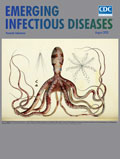
Volume 26, Number 8—August 2020
Research
Factors Associated with Prescription of Antimicrobial Drugs for Dogs and Cats, United Kingdom, 2014–2016
David A. Singleton , Gina L. Pinchbeck, Alan D. Radford, Elena Arsevska, Susan Dawson, Philip H. Jones, Peter-John M. Noble, Nicola J. Williams, and Fernando Sánchez-Vizcaíno
, Gina L. Pinchbeck, Alan D. Radford, Elena Arsevska, Susan Dawson, Philip H. Jones, Peter-John M. Noble, Nicola J. Williams, and Fernando Sánchez-Vizcaíno
Abstract
Antimicrobial stewardship is a cornerstone of efforts to curtail antimicrobial resistance. To determine factors potentially influencing likelihood of prescribing antimicrobials for animals, we analyzed electronic health records for unwell dogs (n = 155,732 unique dogs, 281,543 consultations) and cats (n = 69,236 unique cats, 111,139 consultations) voluntarily contributed by 173 UK veterinary practices. Using multivariable mixed effects logistic regression, we found that factors associated with decreased odds of systemic antimicrobial prescription were client decisions focused on preventive health: vaccination (dogs, odds ratio [OR] 0.93, 95% CI, 0.90–0.95; cats, OR 0.92, 95% CI 0.89–0.95), insurance (dogs, OR 0.87, 95% CI 0.84–0.90; cats, OR 0.82, 95% CI 0.79–0.86), neutering of dogs (OR 0.90, 95% CI 0.88–0.92), and practices accredited by the Royal College of Veterinary Surgeons (OR 0.79, 95% 95% CI 0.68–0.92). This large multicenter companion animal study demonstrates the potential of preventive healthcare and client engagement to encourage responsible antimicrobial drug use.
Antimicrobial drug use is a key driver of the promotion and transmission of antimicrobial resistance in humans, livestock, and companion animals (e.g., dogs, cats) (1–5). Of these groups, the role of companion animals in the development (1,2), carriage, (6) and transmission of antimicrobial-resistant bacteria among animal and human populations is being increasingly realized, partly because of the close proximity in which these animals reside with humans (5,7,8). Indeed, companion animals are now included in recent global action plans aimed at tackling the global health threat of antimicrobial resistance (9).
In human medicine, electronic health records (EHRs) and qualitative research techniques have been used extensively to identify practitioner- and patient-led factors associated with the likelihood of antimicrobial drug prescription (10–13). In veterinary medicine, studies investigating antimicrobial drug prescribing practices and related risk factors are more limited (14). Companion animal research has largely focused on postal surveys (15,16) and in-person interviews (17) to explore perceptions held by veterinary practitioners. However, recent advances in veterinary health informatics have provided opportunities for widescale use of veterinary EHRs to survey antimicrobial prescription (18,19).
Thus far, key insights into antimicrobial prescription frequency and variety have been demonstrated (20–23), including an apparent increased use of cefovecin in cats (21,22); the World Health Organization considers this third-generation cephalosporin to be a highest priority critically important antimicrobial (HPCIA) (24). Considerable interpractice (20,22), regional (21), and clinical presentation (22,25,26) variability in antimicrobial drug prescription frequency and choice has also been identified. Although previous studies have indicated divergence of veterinary opinion over when antimicrobial therapy is justified and which classes of antimicrobial drugs would be most appropriate (15–17), the reasons why such variation exists are unknown.
To identify factors potentially influencing antimicrobial prescribing in the clinical environment, we analyzed EHRs for a large, diverse population of dogs and cats, collected from a network of volunteer first-opinion (general) veterinary practices across Great Britain (England, Scotland, and Wales). We explored associations between antimicrobial prescription (including antimicrobials authorized for systemic administration, antimicrobials authorized for topical administration, and HPCIAs) and a range of veterinary practice, practitioner, client, and animal-related factors (including socioeconomic factors and preventive healthcare interventions) for animals presented primarily for investigation of disease.






















.png)











No hay comentarios:
Publicar un comentario